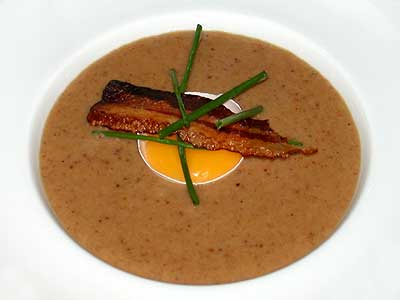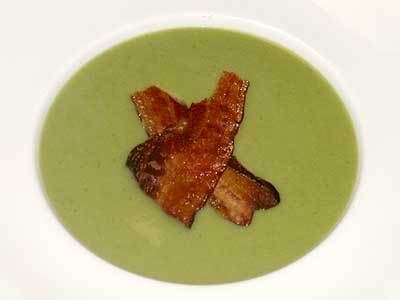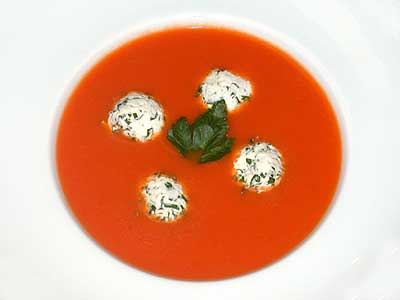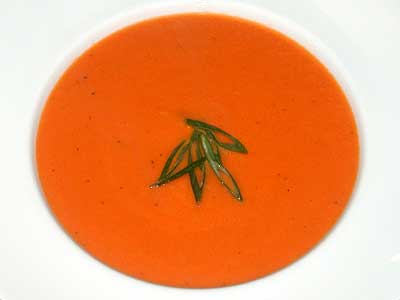























Consommés are arguably the “nobility” of soups. With their clear, clean appearance and full flavors, these soups express “elegance.” The consommé below produces an elegant soup from inexpensive ingredients. Although there are many steps and much elapsed time in its preparation, this soup actually requires relatively little actual time in front of the stove. The results are both elegant to observe and elegant on the tongue.




Although there are only a few common ingredients in this soup, the results are exquisite — bright, clean tasting, and quick.




This is a great soup for when the quality of the artichokes are not so pretty — simply trim away all the ugly parts. The final soup is pureed from the solid, cooked artichoke hearts causing their appearance to be of no importance.




The soup that results from this recipe is so thick that the decoration literally sits on top of the finished soup. Although the soup is thick, it is also very smooth and satisfying.




This simple soup only has a few common ingredients, but the walnuts make it truly unusual. And, unlike its cousin chestnut soup, this one has ingredients that are available all year ‘round.




Bean soups may normally be thought of as being rustic, but this bean soup is as elegant as a soup can be.




Garbure is a traditional winter soup made from common ingredients. This is a soup with lots of chunkies. It is hardy without being heavy. Great for cold days. And by reducing the amount of liquid, this soup becomes a vegetable stew.
The following recipe is adapted from what was reported to be a Parisian version of this traditional soup from the Béarn region of France where it is made with goose confit instead of smoked pork.
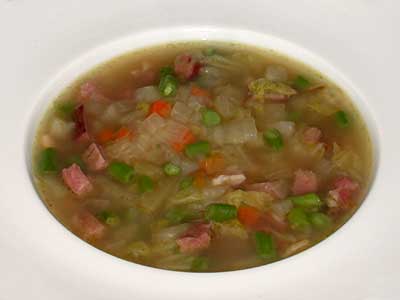



This soup could easily be called a stew because of the amount of solid ingredients in the final product. But there’s a lot of liquid so here it’s being classified as a soup. Either way, serve this soup with a couple of pieces of hearty bread for an excellent winter meal by itself.
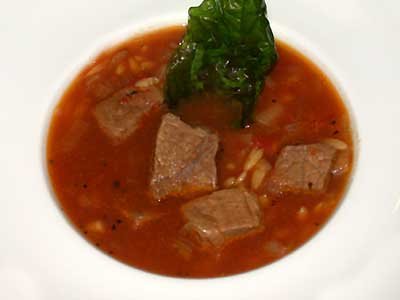



L’ABC de la Gastronomic Française defines bisque as a “thick shellfish soup, with white wine, Cognac, and fresh cream added.” The Larousse Gastronomique adds that the term bisque “suggests a connection with the Spanish province of Vizcaya, which lends its name to the Bay of Biscay.” It also states that bisques were originally boiled dishes of highly-spiced meat. Later, bisques were made with pigeons or quails and garnished with cheese and crayfish. In the 17th century, crayfish became the main ingredient. Later, other crustaceans were used for this dish.
The bisque recipe below is from Ali-Bab’s Gastronomie Pratique, written early in the 20th century. The recipe calls for a base of crayfish and chicken. As translated and tested below, the crayfish have been replaced with shrimp, which produce an equivalent flavor and are more readily available in my part of the world. Other crustaceans would work as well.
Typical of many recipes from a hundred years ago, but rare nowadays, the principal thickening agent of this soup is rice. Today, it is more common to find flour in the form of a roux or beurre manié used for thickening. In my opinion, the rice provides a smoother finish to the soup than is obtainable with a flour preparation.
One concession to modern times is the use of a food processor for pureeing the solids after cooking. In Ali-Bab’s time, a mortar and pestle were used to puree the solids.
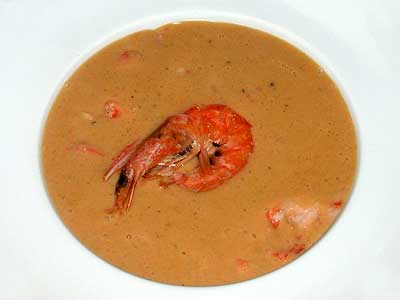



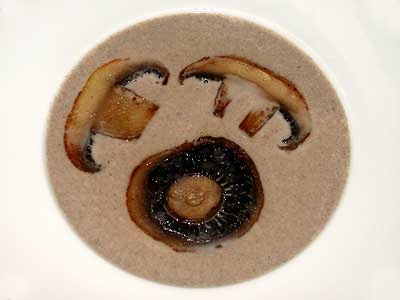



This soup has many levels of flavors. In a sense, it is a pureed choucroute garni, and a soup is not the form one normally eats this Alsatian dish. The original recipe dates back to the early twentieth century, and maybe even earlier.
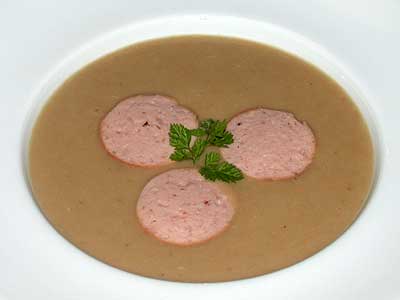



In France, soup is not just soup. What in English is called soup, in France may be called crème, velouté, or potage. If the soup is clear it may be a consommé. If the main ingredient is onions and there’s melted cheese on top, the soup may be called a gratinée. Without the cheese it may be called a tourain, but a tourain may also be made from garlic. If the soup is prepared in a particular pot called a marmite, then the soup may be called a marmite, too. (In other countries, a marmite may be thought of as more of a stew than a soup.) If the soup is thick, creamy, and made from crustaceans, then it may be called a bisque. If the soup is made from vegetables and ham, it made be called a garbure. Sometimes, just to provide more confusion, a soup in French is called a soupe.
Escoffier, in Le Guide Culinaire (1902), provided a strict classification system so that each different type of soup was defined and its name would always mean the same thing, but his system has not made it into general usage. Chefs today run fast and loose when naming soups. But this is nothing new, Escoffier complained that “It can be frequently seen, particularly in the case of thick soups, that the same [recipe] is used indiscriminately for bisque, purées, coulis, and veloutés as well as for crèmes, whereas each term should logically designate a particular preparation of which the [recipe] for each is totally different.” [A Escoffier, Le Guide Culinaire, (HL Cracknell, RJ Kaufman, translators), New York: Mayflower Books, 1982, page 65.]
The soup recipes presented in this article were culled from a variety of modern and traditional sources. Each is presented for making either two or four 225-ml (7-fl. oz.) servings. They represent a mere sampling of the many French soup recipes available — Escoffier alone presents over 400 soup recipes in Le Guide Culinaire — but they also represent the broad variety of soup types and ingredients found in French cuisine today.
• chicken consommé
• carrot soup
• artichoke soup
• crème de chou-fleur au cerfeuil
• cauliflower soup with chervil
• walnut soup
• white bean soup
• garbure
• vegetable and ham soup
• beef stew
• shrimp soup
• mushroom soup
• sauerkraut and sausage soup
• potage crème veloutée de topinambours
• Jerusalem artichoke soup
• potato-leek soup
• celery soup
• soupe de jus d’asperges verte
• asparagus soup
• garden vegetable soup
• garlic soup
• velouté d’épinards aux moules
• spinach soup with mussels
• velouté de pain, œuf canaille
• bread soup with a raw egg
• velouté de petits pois au lard croustillant
• pea soup with bacon
• velouté de poivron rouge et billes de chèvre frais
• sweet, red pepper soup with goat cheese
• tomato soup



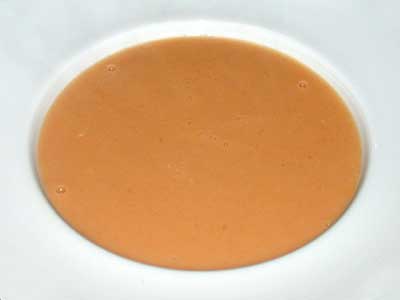



Potato and leek soups are common in most of the cuisines of Europe. This version has a few subtle, extra touches that only a master chef like Joël Robuchon seems to be able to add.
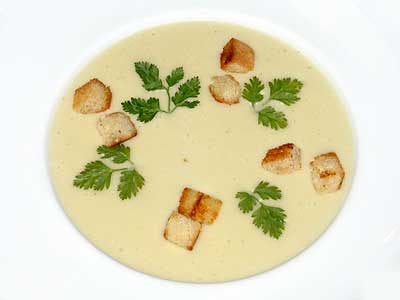



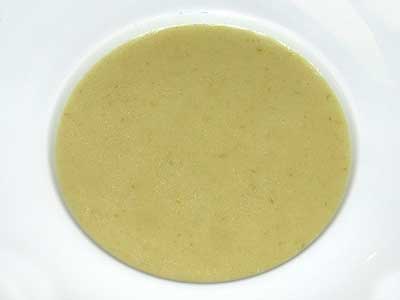



This simple soup is nothing more than asparagus juice that’s gently heated, seasoned with a little salt, and finished with a little butter. As shown below, the garnish is asparagus tips and chives, but many other garnishes will work just as well. What really separates this soup from other asparagus soups is that it is made from juice, not from pureed asparagus.
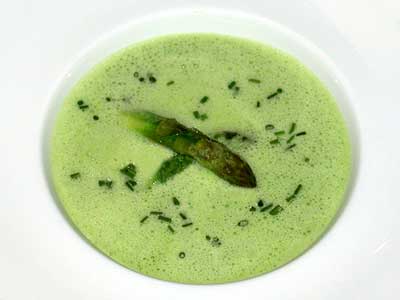



This vegetable soup can be prepared in 30 minutes from start to serving. What could be simpler? (And it tastes great!)
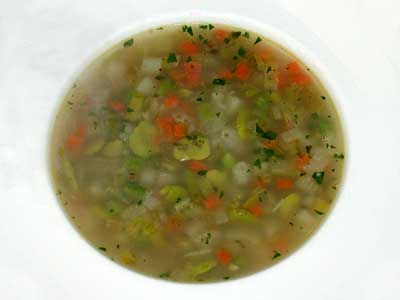



This is another traditional French soup. It originally was made mostly with onions, but it is not uncommon nowadays to find it with garlic as in the following version. Cooked in this manner, the garlic becomes sweet and the soup, light.
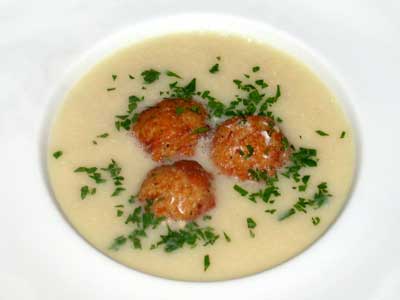



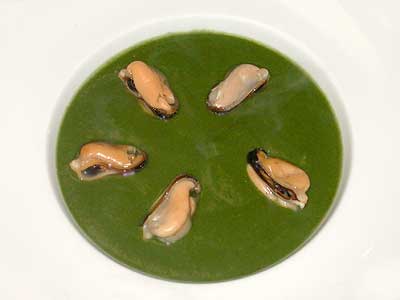



Bread is not normally thought of a main ingredient for a soup. Loaves of bread were used as soup bowls during the middle ages and bread has been a common accompaniment to soups since the earliest of times. So why not make a soup from bread?
